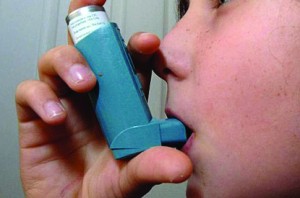According to the Center for Disease Control (CDC), in 2010, asthma affected almost ten percent of people in the United States. Allergens are common triggers for asthma attacks, and lately scientists have investigated fungi as potential culprits. The results from a new study conducted by Yale Environmental Engineering doctoral student Karen Dannemiller and Associate Professor of Chemical and Environmental Engineering Jordan Peccia reveal a surprising twist in the effects of fungal dust exposure. Exposure to a plethora of diverse fungi tends to correlate with lower likelihoods of asthma development.
Yale researchers, working with the California Department of Public Health and the University of California, analyzed fungal dust provided by a previous 2005 health study at the Center for the Health Assessment of Mothers and Children of Salinas (CHAMACOS) birth cohort in Salinas Valley, California. At the time of the previous study, the children were under a year old, which is when asthma generally develops. Researchers then followed up with 41 members of the original study, now aged around seven years old, which is the age required for a diagnosis of asthma. The prominence and variance of multiple fungi were analyzed with next-generation DNA sequencing. Researchers correlated the prevalence of asthma development with factors including dampness, dust levels of various species, and the number of different fungal species present in the household.

The data, obtained from next-generation sequencing of various fungi, were counterintuitive: no single species of fungus positively correlated to asthma, and in fact exposure to high fungal diversity in early life seemed to decrease the likelihood of developing asthma.
“We expected to find one or more fungal species or taxa that were associated with childhood asthma development,” wrote Dannemiller in an email interview. “Despite the thorough analysis provided by next-generation DNA sequencing, we found that no taxa were positively associated with asthma development. Instead, overall fungal diversity was important.”
Next-generation sequencing, a powerful tool to quickly analyze and compare multiple DNA sequences, made analysis of the multitude of different fungi present in dust possible. By being able to analyze multiple strands of DNA in parallel, next-generation sequencing cut the time necessary to analyze multiple strains of fungi and characterize different species found in the dust samples. This method allowed for a more accurate characterization of biodiversity.
“For at least 20 years,” said Peccia, “scientists have understood that microbial diversity is very large and that prior methods to assay environmental exposure to bacteria and fungi result in a severe underestimation of fungal and bacterial diversity. DNA sequencing-based approaches for describing and quantifying fungal diversity simply have not permeated the asthma epidemiology world. To us, this seemed like a missed opportunity.”
With a broadened view of the microbial diversity of the households, stronger hypotheses can be made concerning the relationship between the prevalence of certain fungi and asthma development. The implication that decreasing fungal diversity increases the likelihood for asthma development challenges notions that a sterile environment would be able to prevent asthma development. By expanding concerns beyond what has been traditionally focused on, such as water damage and single fungal species, more steps can be made to develop preventative measures to asthma development. Knowledge of what can influence fungal diversity, such as ventilation, pets, and location, may help in designing houses that minimize the chances of developing asthma.
The application of novel genomic sequencing techniques has yielded results dramatically different from what researchers had expected. Dannemiller is already exploring the findings more deeply. “One project explores housing factors and how they influence bacterial and fungal communities in homes,” he explained. “The second project explores microbial exposures and associations with asthma severity, instead of asthma development in our previous study.”
The study impacts not only our understanding of asthma development, but also highlights the enormous effect of technology on data collection and processing. An interdisciplinary approach, combining epidemiology, genetics and engineering, was crucial to producing and analyzing the results.
“I was excited to have the opportunity to be involved in interdisciplinary research,” said Dannemiller. “I now have experience incorporating environmental measurements into public health research to yield new insights into disease.”
